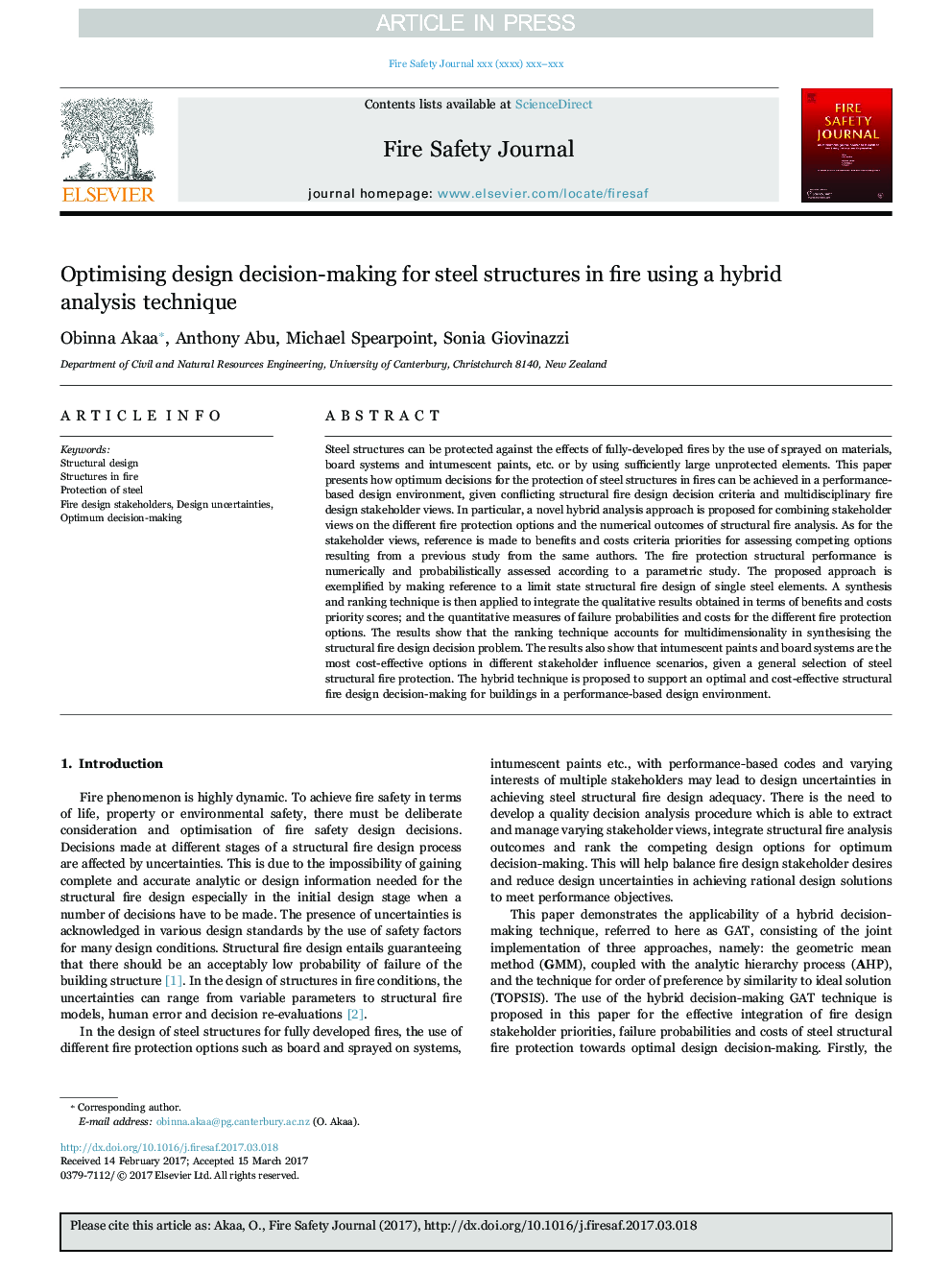| کد مقاله | کد نشریه | سال انتشار | مقاله انگلیسی | نسخه تمام متن |
|---|---|---|---|---|
| 4920936 | 1429212 | 2017 | 10 صفحه PDF | دانلود رایگان |
عنوان انگلیسی مقاله ISI
Optimising design decision-making for steel structures in fire using a hybrid analysis technique
ترجمه فارسی عنوان
بهینه سازی تصمیم گیری طراحی برای سازه های فولادی در آتش با استفاده از تکنیک تجزیه و تحلیل ترکیبی
دانلود مقاله + سفارش ترجمه
دانلود مقاله ISI انگلیسی
رایگان برای ایرانیان
کلمات کلیدی
طراحی سازه، سازه های آتش، حفاظت از فولاد، سهامداران طراحی آتش، عدم قطعیت طراحی، تصمیم گیری بهینه،
ترجمه چکیده
ساختارهای فولادی می توانند در برابر اثرات آتش سوزی به طور کامل توسط استفاده از اسپری بر روی مواد، سیستم های تخته ای و رنگ های درخشان و غیره یا با استفاده از عناصر محافظت نشده به اندازه کافی محافظت شوند. این مقاله نشان می دهد که چگونه تصمیمات بهینه برای محافظت از سازه های فولادی در آتش می تواند در یک محیط طراحی مبتنی بر عملکرد به دست آید، با توجه به معیارهای تصمیم سازنده طراحی طراحی آتش نشانی و دیدگاه های ذینفعان طراحی چند رشته ای. به طور خاص، یک رویکرد تجزیه و تحلیل ترکیبی جدید برای ترکیب نظرات ذینفعان در مورد گزینه های مختلف حفاظت از آتش و نتایج عددی از تجزیه و تحلیل آتش ساختاری پیشنهاد شده است. در مورد دیدگاه های ذینفع، ارزیابی مزایا و هزینه های اولویت های معیاری برای ارزیابی گزینه های رقابت از نتایج مطالعات قبلی از همان نویسندگان، ارجاع می شود. عملکرد ساختاری حفاظت از آتش سوزی به صورت عددی و احتمالا بر اساس یک مطالعه پارامتری ارزیابی می شود. رویکرد پیشنهادی با اشاره به یک طراحی محدود از ساختار آتش سوزی ساختار عناصر فولادی است. پس از آن یک روش سنتز و رتبه بندی برای تلفیق نتایج کیفی بدست آمده از نظر مزایا و هزینه های اولویت بندی اعمال می شود. و اندازه های کمی از احتمالات شکست و هزینه های مختلف گزینه های حفاظت از آتش سوزی. نتایج نشان می دهد که تکنیک رتبه بندی برای چند بعدی بودن در ساختن تصمیم گیری ساختاری طراحی طراحی آتش طراحی شده است. نتایج همچنین نشان می دهد که رنگ های رنگ آمیزی و سیستم های هیئت مدیره گزینه های مقرون به صرفه ترین در سناریوهای مختلف نفوذ ذینفعان است، با توجه به انتخاب کلی از حفاظت از ساختار فولاد سازه فولادی. تکنیک ترکیبی پیشنهاد شده است تا از تصحیح تصمیم گیری طراحی مناسب برای ساختمان ها در یک محیط طراحی مبتنی بر عملکرد پشتیبانی کند.
موضوعات مرتبط
مهندسی و علوم پایه
سایر رشته های مهندسی
مهندسی عمران و سازه
چکیده انگلیسی
Steel structures can be protected against the effects of fully-developed fires by the use of sprayed on materials, board systems and intumescent paints, etc. or by using sufficiently large unprotected elements. This paper presents how optimum decisions for the protection of steel structures in fires can be achieved in a performance-based design environment, given conflicting structural fire design decision criteria and multidisciplinary fire design stakeholder views. In particular, a novel hybrid analysis approach is proposed for combining stakeholder views on the different fire protection options and the numerical outcomes of structural fire analysis. As for the stakeholder views, reference is made to benefits and costs criteria priorities for assessing competing options resulting from a previous study from the same authors. The fire protection structural performance is numerically and probabilistically assessed according to a parametric study. The proposed approach is exemplified by making reference to a limit state structural fire design of single steel elements. A synthesis and ranking technique is then applied to integrate the qualitative results obtained in terms of benefits and costs priority scores; and the quantitative measures of failure probabilities and costs for the different fire protection options. The results show that the ranking technique accounts for multidimensionality in synthesising the structural fire design decision problem. The results also show that intumescent paints and board systems are the most cost-effective options in different stakeholder influence scenarios, given a general selection of steel structural fire protection. The hybrid technique is proposed to support an optimal and cost-effective structural fire design decision-making for buildings in a performance-based design environment.
ناشر
Database: Elsevier - ScienceDirect (ساینس دایرکت)
Journal: Fire Safety Journal - Volume 91, July 2017, Pages 532-541
Journal: Fire Safety Journal - Volume 91, July 2017, Pages 532-541
نویسندگان
Obinna Akaa, Anthony Abu, Michael Spearpoint, Sonia Giovinazzi,
